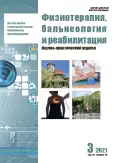Experience of using the sensor treadmill to improve the functions of pacing, cognitive abilities and psychoemotional status in patients with ischemic stroke
- Authors: Mikhailova A.A.1,2, Korchazhkina N.B.1, Koneva E.S.2,3, Kotenko K.V.1, Elfimov M.A.4
-
Affiliations:
- Petrovsky National Research Centre of Surgery
- Group of Companies MEDSI
- The First Sechenov Moscow State Medical University (Sechenov University)
- Central State Medical Academy of Department of Presidential Affairs
- Issue: Vol 20, No 3 (2021)
- Pages: 221-228
- Section: Original studies
- URL: https://journals.rcsi.science/1681-3456/article/view/106154
- DOI: https://doi.org/10.17816/1681-3456-2021-20-221-227
- ID: 106154
Cite item
Abstract
BACKGROUND: Stroke in developed countries continues to be the most important medical and social problem and occupy a leading position in the structure of morbidity and mortality.
AIMS: To study the effect of the technique of robotic biomechanical rehabilitation on a sensory treadmill with built-in power platforms and biofeedback in patients with post-stroke spasticity on the main indicators of stride, cognitive function and psychoemotional status in the late recovery period.
MATERIAL AND METHODS: The study included 80 patients who underwent ischemic stroke with movement disorders in the form of hemiparesis with increased muscle tone by the type of spasticity in the upper and lower extremities in the late recovery period, who were divided into 2 groups: the control group ― 40 people, who received standard drug therapy and medical rehabilitation, including medical massage, exercise therapy and kinesitherapy, and the main group ― 40 people, who, against the background of standard drug therapy and medical rehabilitation, underwent training on a sensory treadmill with built-in power platforms and biofeedback. Objective indicators of step function, subjective indicators of cognitive impairment (Montreal Cognitive Assessment Scale, MoCA) and psychoemotional defects (Hospital Anxiety and Depression Scale, HADS) were assessed.
RESULTS: When analyzing the data after the course of treatment in the patients of the main group, the indicators of the parameters of the walking stereotype improved significantly compared to the data in the control group, the cognitive functions normalized, and the degree of psychoemotional defect decreased, which was confirmed by the MoCA and HADS scales.
CONCLUSION: The inclusion of training on a sensory treadmill with built-in power platforms and biofeedback in the standard complex of medical rehabilitation of patients who have suffered an ischemic stroke with movement disorders in the form of hemiparesis in the lower extremities in the late recovery period contributes to a significant improvement in the biomechanical indicators of stride, cognitive functions and a decrease in the degree of psychoemotional impairment.
Full Text
##article.viewOnOriginalSite##About the authors
Anna A. Mikhailova
Petrovsky National Research Centre of Surgery; Group of Companies MEDSI
Author for correspondence.
Email: mikhaylova003@gmail.com
ORCID iD: 0000-0002-4260-1619
SPIN-code: 7673-3241
MD, Cand. Sc. (Med.), Associate Professor
Russian Federation, Moscow; MoscowNatalya B. Korchazhkina
Petrovsky National Research Centre of Surgery
Email: mikhaylova003@gmail.com
ORCID iD: 0000-0001-6913-8778
SPIN-code: 9733-7646
MD, Dr. Sci. (Med.), Professor
Russian Federation, MoscowElizaveta S. Koneva
Group of Companies MEDSI; The First Sechenov Moscow State Medical University (Sechenov University)
Email: mikhaylova003@gmail.com
ORCID iD: 0000-0002-9859-194X
SPIN-code: 8200-2155
MD, Dr. Sci. (Med.), Professor
Russian Federation, Moscow; MoscowKonstantin V. Kotenko
Petrovsky National Research Centre of Surgery
Email: mikhaylova003@gmail.com
ORCID iD: 0000-0002-6147-5574
SPIN-code: 5993-3323
MD, Dr. Sci. (Med.), Professor, Corresponding Member of the Russian Academy of Sciences
Russian Federation, MoscowMikhail A. Elfimov
Central State Medical Academy of Department of Presidential Affairs
Email: mikhaylova003@gmail.com
ORCID iD: 0000-0001-6153-9673
MD, Dr. Sci. (Med.)
Russian Federation, MoscowReferences
- Liao XL, Zuo LJ, Zhang N, et al. The occurrence and longitudinal changes of cognitive impairment after acute ischemic stroke. Neuropsychiatr Dis Treat. 2020;16:807–814. doi: 10.2147/NDT.S234544
- Walker MF, Hoffmann TC, Brady MC, et al. Improving the development, monitoring and reporting of stroke rehabilitation research: consensus-based core recommendations from the Stroke Recovery and Rehabilitation Roundtable. Int J Stroke. 2017;12(5):472–479. doi: 10.1177/1747493017711815
- Abuseva GR, Antipenko PV, Baranovsky AYu, et al. Physical and rehabilitation medicine: a national guide. Interregional Scientific Society of Physical and Rehabilitation Medicine, Association of Medical Societies for Quality. Moscow: GEOTAR-Media; 2020. 688 р. (In Russ).
- Kotenko KV, Epifanov VA, Epifanov AV, Korchazhkina NB. Rehabilitation for diseases and injuries of the nervous system. Moscow: GEOTAR-Media; 2016. 656 p. (In Russ).
- Epifanov VA, Korchazhkina NB. Medical and social rehabilitation of patients with various pathologies. In 2 parts. Moscow: GEOTAR-Media; 2019. 580 p. (In Russ).
- Mikhailova AA, Korchazhkina NB, Koneva ES, Kotenko KV. The psychocorrective effect of using combined methods of medical rehabilitation in patients who have suffered an ischemic stroke. Russian journal of the physial therapy, balneotherapy and rehabilitation. 2020;19(6):380–383. (In Russ). doi: 10.17816/1681-3456-2020-19-6-5
- Koneva ES, Shapovalenko TV, Lyadov KV, et al. The effectiveness of the inclusion of the BOS-video reconstruction technique in the programs of complex rehabilitation of elderly patients. Physiotherapist. 2020;3:6–15. (In Russ). doi: 10.33920/med-14-2006-01
Supplementary files








